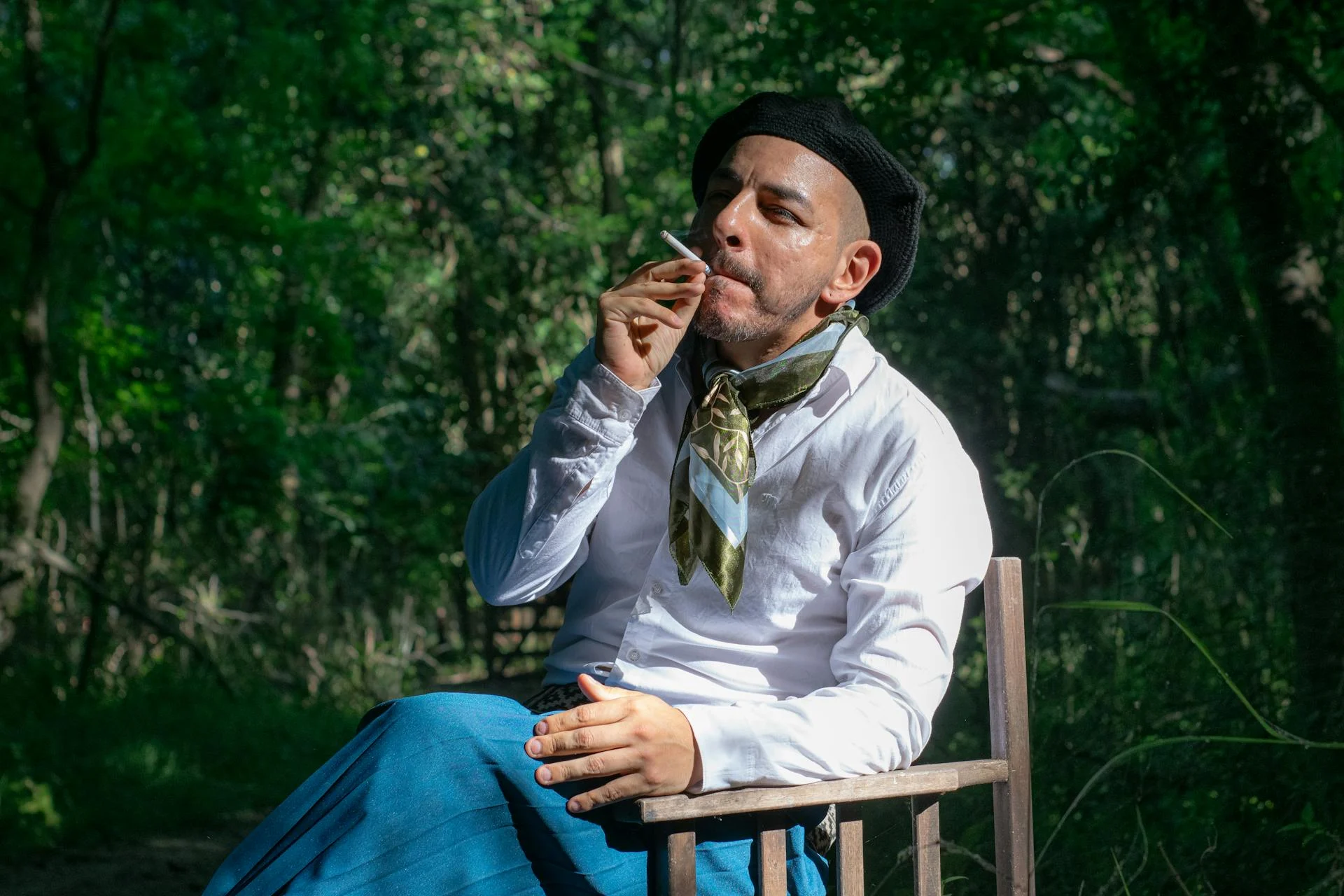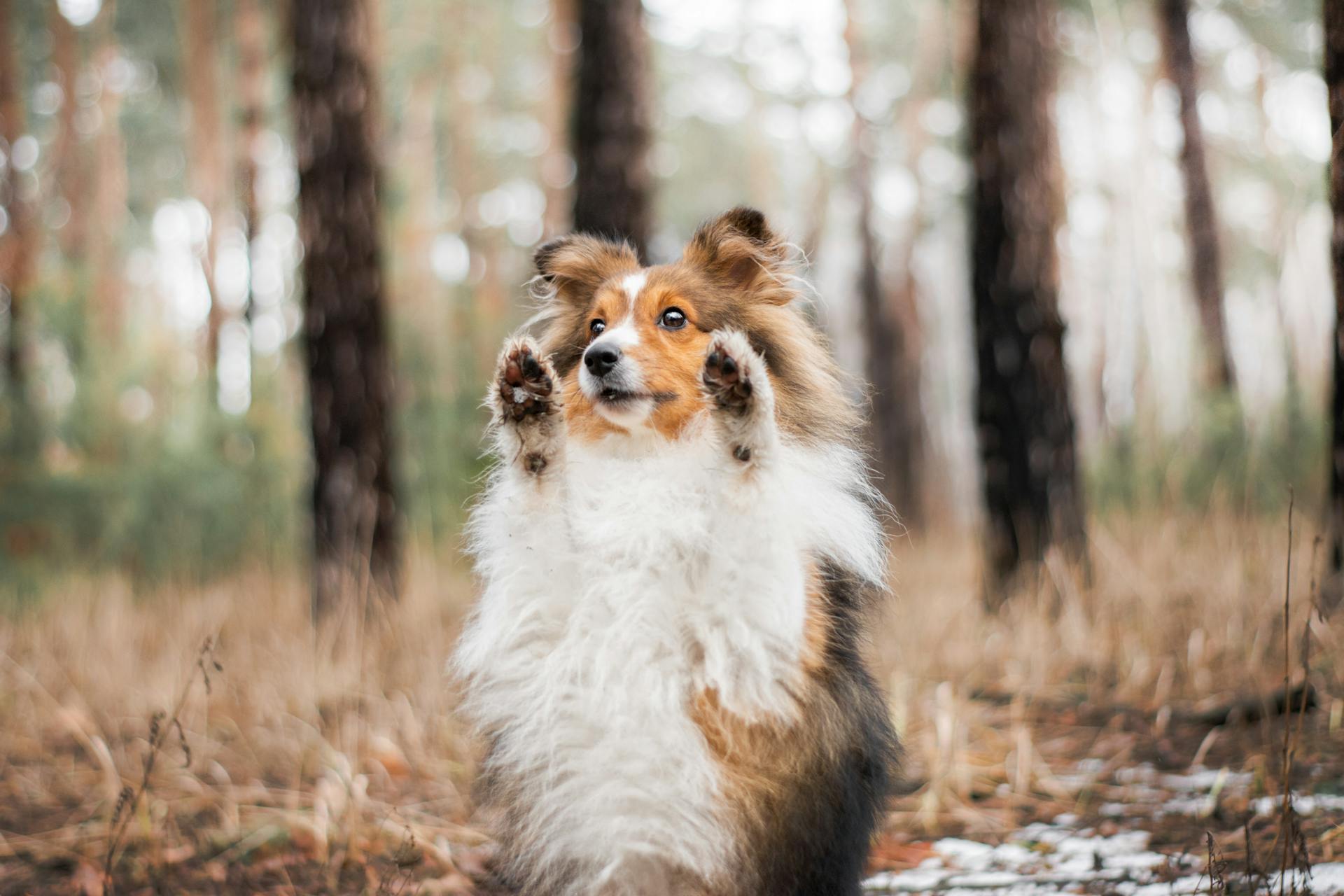
The Shetland Sheepdog, affectionately known as the Sheltie, is a small but mighty breed with a big personality. They are highly intelligent and active dogs that require regular exercise to stay happy and healthy.
Shelties are naturally wary of strangers, so early socialization is crucial to help them feel confident and calm in new situations. With proper training and socialization, they can thrive as loyal and loving companions.
Their thick double coat requires regular grooming to prevent matting and tangling, and they shed heavily during shedding season. This means they need to be brushed several times a week, especially during shedding season.
Shelties are generally quiet dogs, but they do have a tendency to bark when they sense something unusual or when they're trying to alert their owners to potential threats.
Broaden your view: When Do Border Collies Stop Growing
Breed History
The Shetland Sheepdog, also known as the Sheltie, has a rich history that dates back to around 900 A.D. when the islands off the coast of Scotland were colonized by Norse people who brought with them the ancestors of the Shetland Sheepdog.
These ancestors were Spitz-type dogs, similar to today's Icelandic Sheepdog and the Swedish Vallhund. The Shetland islanders developed a small, highly intelligent dog that could herd with little or no supervision.
The harsh climate of the Shetland Islands required a hardy, small dog with a thick, weather-resistant coat. This led to the development of a breed that was perfectly suited to its environment.
In the 15th century, Shetland became part of Scotland and began importing sheep from the mainland. This led to the crossing of the Shetland dogs with the Scottish Collie to give the island breed a more distinct Collie-like appearance.
The Shetland Sheepdog was primarily used for herding sheep, poultry, and ponies on the rugged and remote Shetland Islands. Its ancestors include the Rough Collie, the Icelandic Sheepdog, and possibly some small Scandinavian breeds.
The breed's journey to official recognition began in the early 20th century, with the first Shetland Sheepdogs being registered in England in 1909. However, those early Shelties were quite varied in appearance.
The American Kennel Club (AKC) recognized the Shetland Sheepdog in 1911, providing a significant boost to the breed's popularity in the United States. The Royal Kennel Club (UK) also recognized the breed, further solidifying its status as a distinct purebred.
Related reading: Border Collies Herding Sheep
The Shetland Sheepdog was bred to be a smaller version of the Rough Collie, with the goal of creating a dog that was similar in appearance but smaller in size. This selective breeding process took several decades to establish the consistency of type that is seen in the breed today.
The Shetland Sheepdog quickly gained popularity for its beauty, intelligence, and versatility. Today, the breed excels in various canine sports and extracurricular activities, showcasing its agility, obedience, and herding capabilities.
The Shetland Sheepdog's long history as a herding and working dog on the Shetland Islands has left a lasting legacy on its lively temperament and undeniable abilities. These intelligent and energetic dogs continue to thrive in active households, bringing joy and companionship to those who welcome them into their lives.
The Shetland Sheepdog was first bred in the 1800's and is most likely descended from Scottish herding dogs that were bred with Collies. The lack of vegetation in the area led to smaller livestock, which meant that this smaller dog was favored.
The Shetland Sheepdog was taken to England by naval fleets, where it soon became a popular pet. Today, it is one of the most popular breeds in America.
A good sheep-herding dog was indispensable to farmers on the Shetland Islands, but keeping a large breed dog nourished was no easy feat. The obedient, people-pleasing Rough Collie was a phenomenal working breed, but its large size and appetite made it impractical for impoverished farmers.
The Shetland Sheepdog was effectively "downsized" through selective breeding, retaining its ancestral instincts and proving highly capable of herding a variety of farmed animals.
The Shetland Islands are fifty miles from the nearest mainland shore, and the Sheltie was isolated from the rest of Europe for many years. The breed spent much of its early history unknown to the rest of the world, a treasure yet to be discovered.
Today, the Sheltie is not only a competent herder but an athlete of choice for many dog sports enthusiasts. Shelties are sure to dominate their class in agility trials and are one of the most common breeds to place at national and international competition levels.
On a similar theme: Sheltie Rough Collie
Physical Characteristics
The Shetland Sheepdog, or Sheltie, is a small to medium-sized breed that stands between 13 and 16 inches tall at the shoulder.
Their weight typically ranges from 15 to 25 pounds, making them a compact and agile dog. In terms of height and weight, they are proportionate to one another.
The Sheltie's head is refined and proportionate to the size of their body, with a flat skull and a muzzle that is parallel to the skull. Their eyes are medium in size, almond-shaped, and set obliquely, giving them a keen and inquisitive expression.
Worth a look: Sheltie Dog Names
Characteristics
The Shetland Sheepdog is a highly intelligent breed, recognized by kennel organizations worldwide for its unique characteristics. This breed is categorized under a specific Group designation, which varies depending on the registry.
The Sheltie's high intelligence makes it an excellent worker, exceling in performance events. It's also a willing learner, which is a testament to its intelligence.
One of the Shetland Sheepdog's most notable characteristics is its loyalty to family members. It's intensely devoted to its pack, including children and other dogs. This loyalty makes it an excellent companion animal.
A fresh viewpoint: Characteristics of a Lhasa Apso
The Shetland Sheepdog is known to be wary of strangers, but once it gets to know you, it's a loyal friend. However, it can be prone to shyness, timidity, and nervousness in new situations.
Here are some key breed standards from leading kennel organizations:
The Shetland Sheepdog's alert nature makes it an excellent guard dog, warning its family of any potential threats with enthusiastic barking.
Height and Weight
Shelties are a small to medium-sized breed, with adult dogs typically standing between 13 and 16 inches tall at the shoulder.
Their compact size makes them suitable for various living situations, but it's essential to remember that they are an active breed that requires regular exercise.
A mature Sheltie usually weighs between 15 and 25 pounds, with some dogs being over- or undersized.
Shelties have a well-balanced and symmetrical appearance, with a strong and agile physique that's perfect for herding and farm work.
Their body length is slightly longer than their height at the shoulder, giving them a slightly elongated appearance.
Shelties have sturdy bone but are not bulky, maintaining a refined and graceful look.
Regular coat maintenance is a must for Shelties, as their long, flowing double coats require daily brushing to stay in top shape.
Shelties have a distinctive "prick" ear with a small fold at the tip, adding to their elegant appearance.
Their long snout gives them a characteristic Collie-like appearance, making them a beloved breed among dog enthusiasts.
Head
The Shetland Sheepdog's head is a distinctive feature of the breed. It's refined but proportionate to the body size.
From the side, the skull and muzzle are of equal length, parallel, and joined by a slight but definite stop. This is a key characteristic of the breed.
The Sheltie's skull is flat, moderately wide between the ears, and gradually tapers towards the eyes. A slight but definite stop marks the transition from the skull to the muzzle.
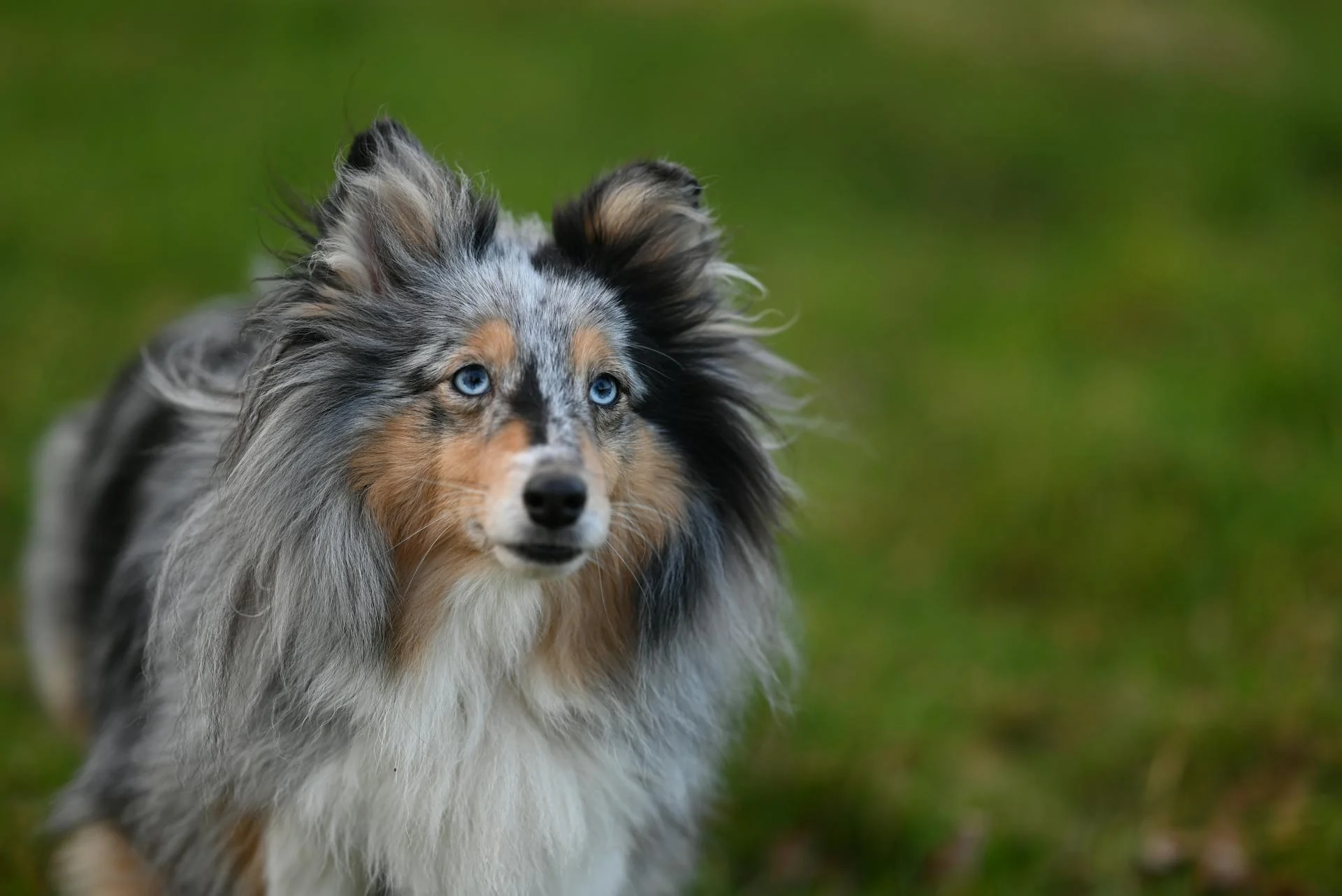
Their eyes sparkle with a keen, inquisitive, and attentive look, reflecting their energetic and intelligent nature. Dark eyes are preferred in all coat colors except for blue merles, where one or both eyes may be blue or have blue segments.
The Sheltie's muzzle is well-rounded, tapering to the nose, and is of a size that's in proportion to the skull. It's not too long or too short, and is parallel to the skull, though on a lower plane.
The nose is black, regardless of the coat color, adding much to the character of the breed's distinctive head and expression.
Worth a look: Boston Terrier Skull
Tail
The tail of the Shetland Sheepdog is set low and carried straight down or slightly curved when the dog is at rest, showcasing a graceful silhouette.
The tail reaches the hock joint, providing an ample canvas for the long, abundant hair that covers it.
As the dog is alert or in motion, the tail may be lifted, but it is never carried over the back.
The Sheltie's tail is never docked, and its profuse coat adds to the overall impression of grandeur created by the mane and frill around the neck and chest.
The hair on the tail is harsh, straight, and stands out from the body, further enhancing the breed's classic appearance.
Recommended read: Straight Backed German Shepherds
Colors
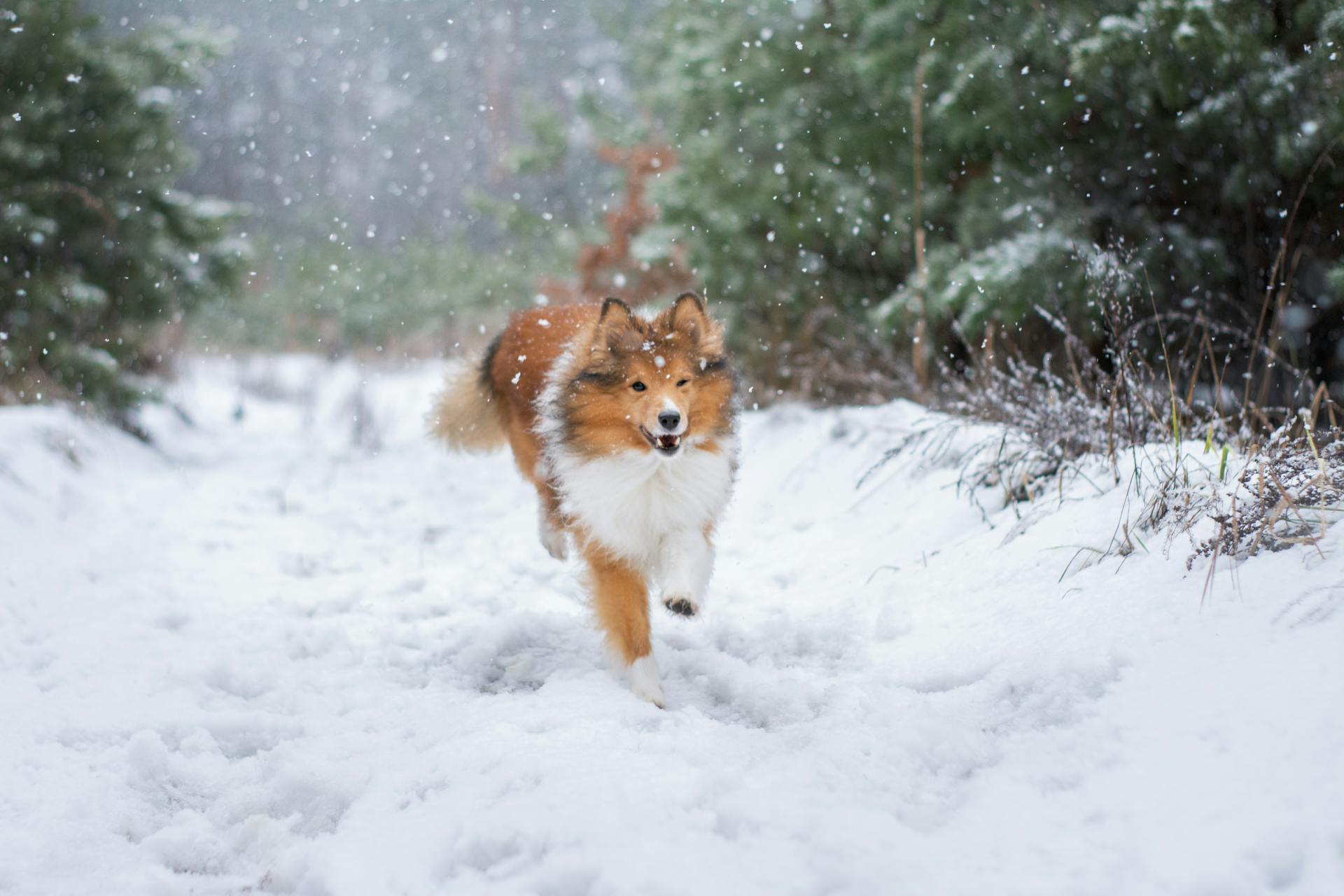
Colors play a significant role in defining the Shetland Sheepdog breed. The Sheltie's coat can come in three basic colors: sable, black, and blue merle.
These colors can be accompanied by varying amounts of white and/or tan markings. Shelties can have a sable coat that ranges from golden to mahogany, a solid black coat, or a blue merle coat with a gray-blue base and black patches.
Shelties with more than 50 percent white on their body or brindle coats are not desirable for the show ring. However, this doesn't affect their ability to make great companions.
A Note About Color: The Shetland Sheepdog's coloration may be either black, blue merle, or sable, with varying degrees of white and/or tan markings.
Coat Color and Grooming
Shetland Sheepdogs have a beautiful, thick double coat that requires regular grooming to prevent matting and tangling. This coat is a hallmark of the breed and consists of a long, straight, and harsh outer coat with a dense, soft undercoat.
The Sheltie's coat is smooth on the face, tips of the ears, and feet, but abundant on the mane and frill as well as on the tail. This unique coat texture and structure make it prone to mats and tangles, especially in the areas around the neck, behind the ears, and at the base of the tail.
The Sheltie's coat comes in three basic colors: sable, ranging from golden to mahogany, black, and blue merle (blue-gray with black). White and/or tan markings can also be present. Shelties with more than 50% white or brindle coats won't do well in the show ring, but their color doesn't affect their ability to be a great companion.
Shelties need to be brushed at least weekly, and daily brushing is recommended during shedding season. Use a pin brush to get right down to the skin, and mist the coat with a spray bottle as you go to prevent damage to the hair. Pay special attention to the fine hair behind the ears, which tends to tangle.
Here are the basic grooming requirements for Shelties:
- Daily brushing
- Occasional bathing
- Routine ear cleaning
- Periodic nail trimming
- Regular tooth brushing
By following these grooming requirements, you can keep your Sheltie's coat healthy, shiny, and looking its best. Regular grooming sessions also provide an opportunity to check your Sheltie's skin for any signs of irritation, pests, or abnormalities.
Here's an interesting read: Sheltie vs Shetland Sheepdog
Personality and Temperament
Shetland Sheepdogs are known for their loyal and gentle nature, making them a great fit for families. They are highly intelligent and eager to please, which makes training a breeze.
They have a strong instinct to herd, but this can be managed with early socialization and training. Some Shelties may try to herd small children, so it's essential to supervise interactions.
Shelties are naturally reserved around strangers, but they quickly warm up once they feel safe. They're highly attuned to their environment and can pick up on changes in mood and atmosphere, making them responsive to their owners' needs.
They thrive on being part of the family and can become destructive if left alone for too long. A daily walk and play session are enough to keep them happy and active, and their recall is impressive, often returning promptly when called.
Intriguing read: Border Collies Herding
Behavior and Temperament
Shetland Sheepdogs are known for their sensitive and companionable temperament. They are highly intelligent dogs who love mental stimulation and excel in obedience if given the right training.
Shelties are naturally reserved around strangers, but this usually passes once they've been let into the house and the dog is sure they pose no threat. They have a strong instinct to herd, which can manifest as gentle nudging or herding behaviors, particularly around younger kids.
Shetland Sheepdogs are incredibly loyal and love to be around their owners. They make for a great family pet, but they can try and herd small children. They have a need to be around those close to them and dislike being left alone for too long.
Shelties are highly trainable due to their intelligence and eagerness to please. They respond well to positive reinforcement techniques, such as treats and praise, but don't respond well to harsh training methods.
Shetland Sheepdogs are known for being vocal, and they have a tendency to bark in response to stimuli in their environment. This trait makes them excellent watchdogs, but excessive barking can be managed with proper training and socialization.
Shelties are highly intelligent and rank high in terms of trainability and problem-solving ability. They require mental stimulation to prevent boredom, which often leads to undesirable behaviors.
Good with Cats?
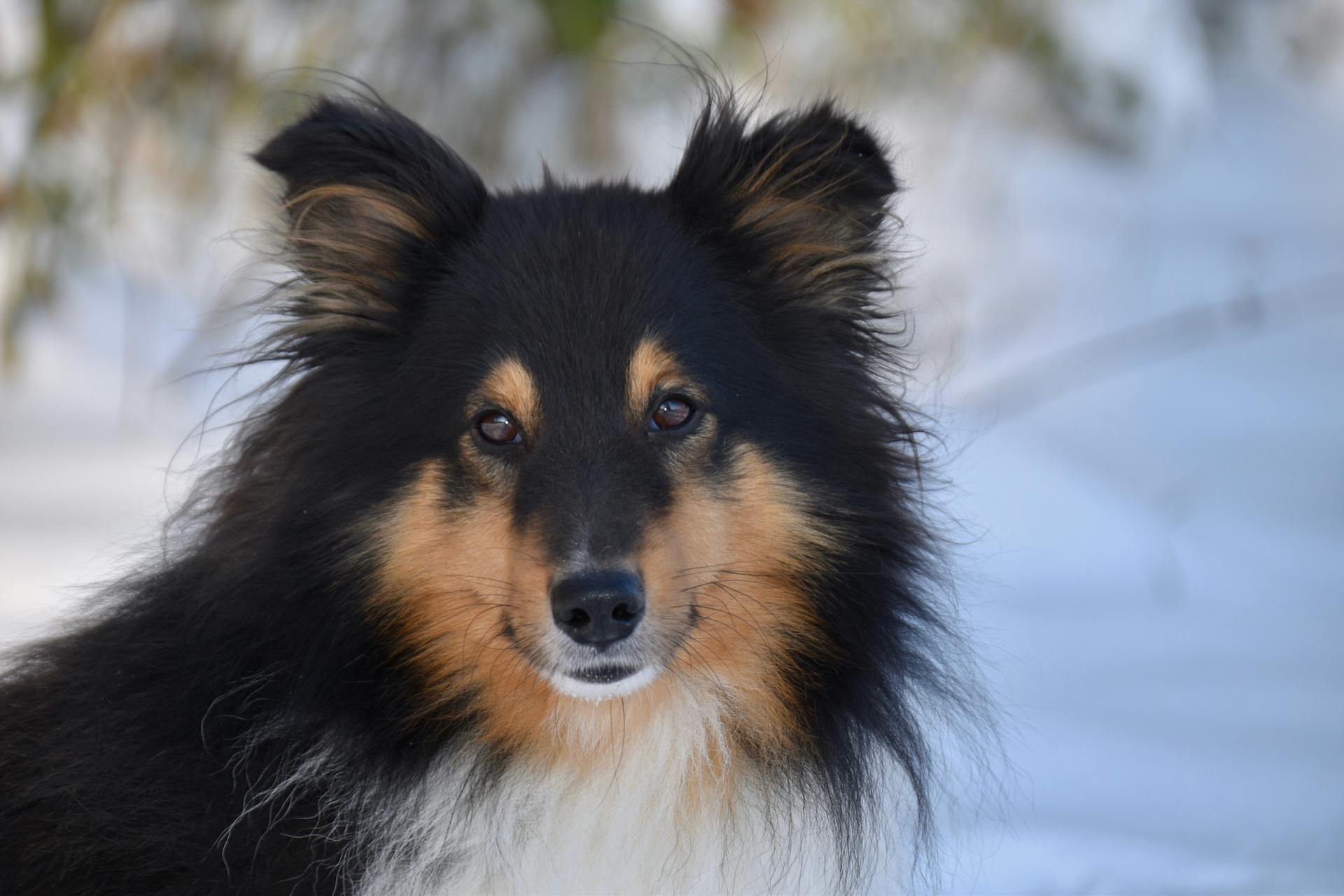
Shetland Sheepdogs can get along well with cats and other pets in the household with proper introduction and socialization.
Their herding instincts may sometimes lead them to try and herd a cat, but this behavior can usually be managed with training.
Supervising initial interactions between a Sheltie and a cat is crucial to encourage the development of a positive interspecies relationship.
Health and Care
Shetland Sheepdogs are generally a healthy breed with an average lifespan of 12 to 14 years. Their small size makes them suitable for apartment living, but they still require daily walks and playtime to stay happy and healthy.
To keep your Sheltie in top shape, regular veterinary check-ups are essential, especially for early detection of potential health issues. These include hip dysplasia, eye conditions such as Collie Eye Anomaly and Progressive Retinal Atrophy, and thyroid issues.
A balanced diet and a safe living environment can also help mitigate these risks. Choosing a reputable breeder who tests their breeding dogs for common health conditions is crucial in ensuring your puppy will be as healthy as possible.
Health
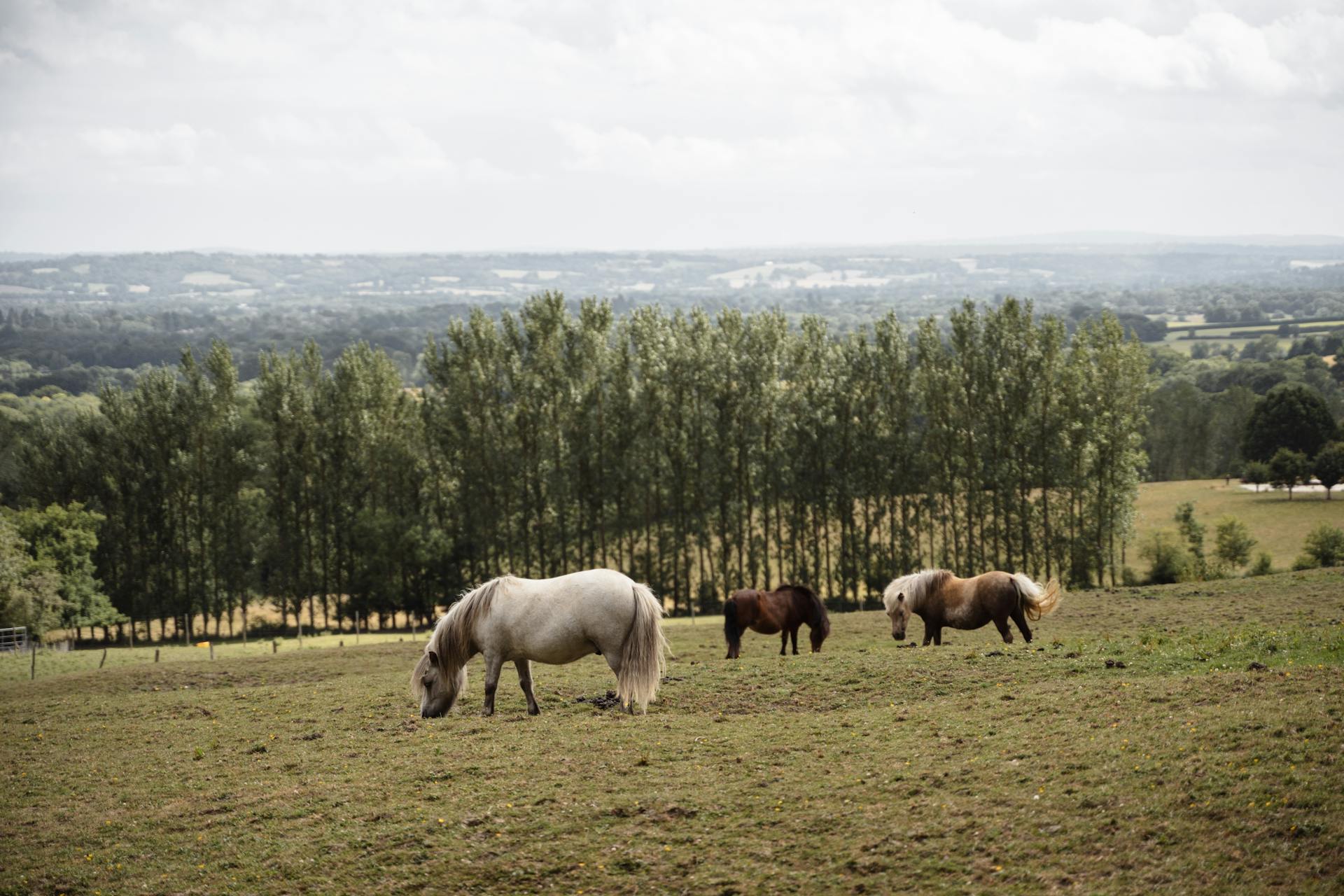
Shetland Sheepdogs are generally a healthy breed, but like all breeds, they can be prone to certain health conditions. Their average lifespan is between 12 to 14 years.
Regular veterinary check-ups are crucial to catch potential health issues early on. This includes monitoring for hip dysplasia, which can cause pain and lameness in the rear legs, and eye conditions such as Collie Eye Anomaly and Progressive Retinal Atrophy (PRA), which can lead to blindness.
Some common health problems in Shelties include dermatomyosis, a disease that causes skin and muscle inflammation, and patellar luxation, a dislocation of the knee cap. Additionally, they can be susceptible to blood clotting disease and certain types of cancer.
To mitigate these risks, it's essential to choose a reputable breeder who tests their breeding dogs for common health conditions. You should also maintain regular veterinary check-ups and provide a balanced diet and a safe living environment.
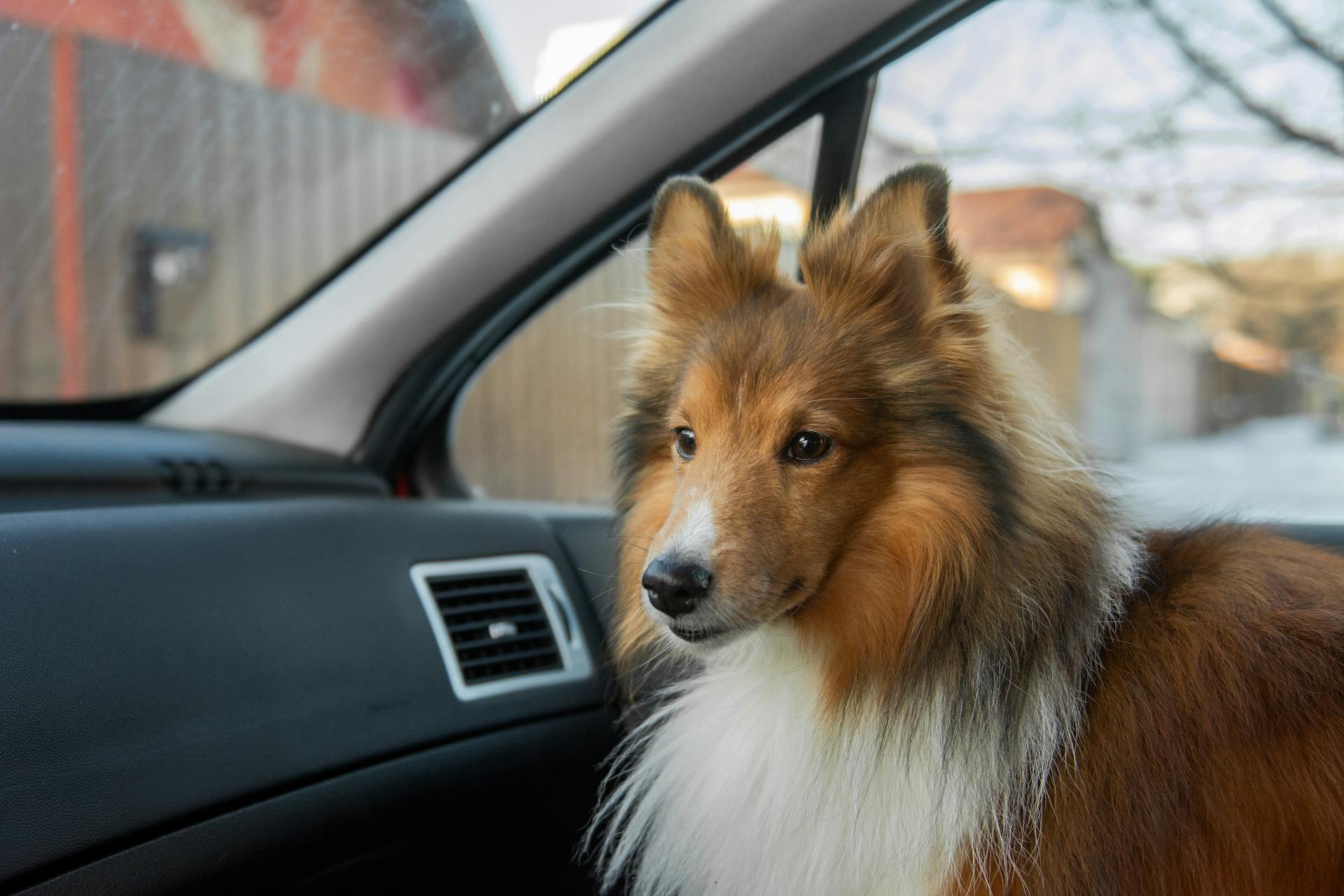
Here are some potential health issues to be aware of in Shetland Sheepdogs:
By being proactive and aware of these potential health issues, you can help ensure the well-being of your Shetland Sheepdog and provide them with a happy and healthy life.
Feeding & Nutrition
Feeding your Shetland Sheepdog the right amount of high-quality food is crucial for its growth and development. Recommended daily amount is 3/4 to 2 cups of high-quality dog food daily, divided into two meals.
A Sheltie's feeding needs depend on its size, age, build, metabolism, and activity level. Dogs are individuals, just like people, and they don’t all need the same amount of food.
You should be able to see a waist on your Sheltie when looking down at them. If you can't, they need less food and more exercise.
Puppies have different nutritional requirements compared to adult dogs. For a Sheltie puppy, it’s recommended to provide high-quality puppy food, divided into three to four meals per day.
For your interest: Are Border Collies High Energy
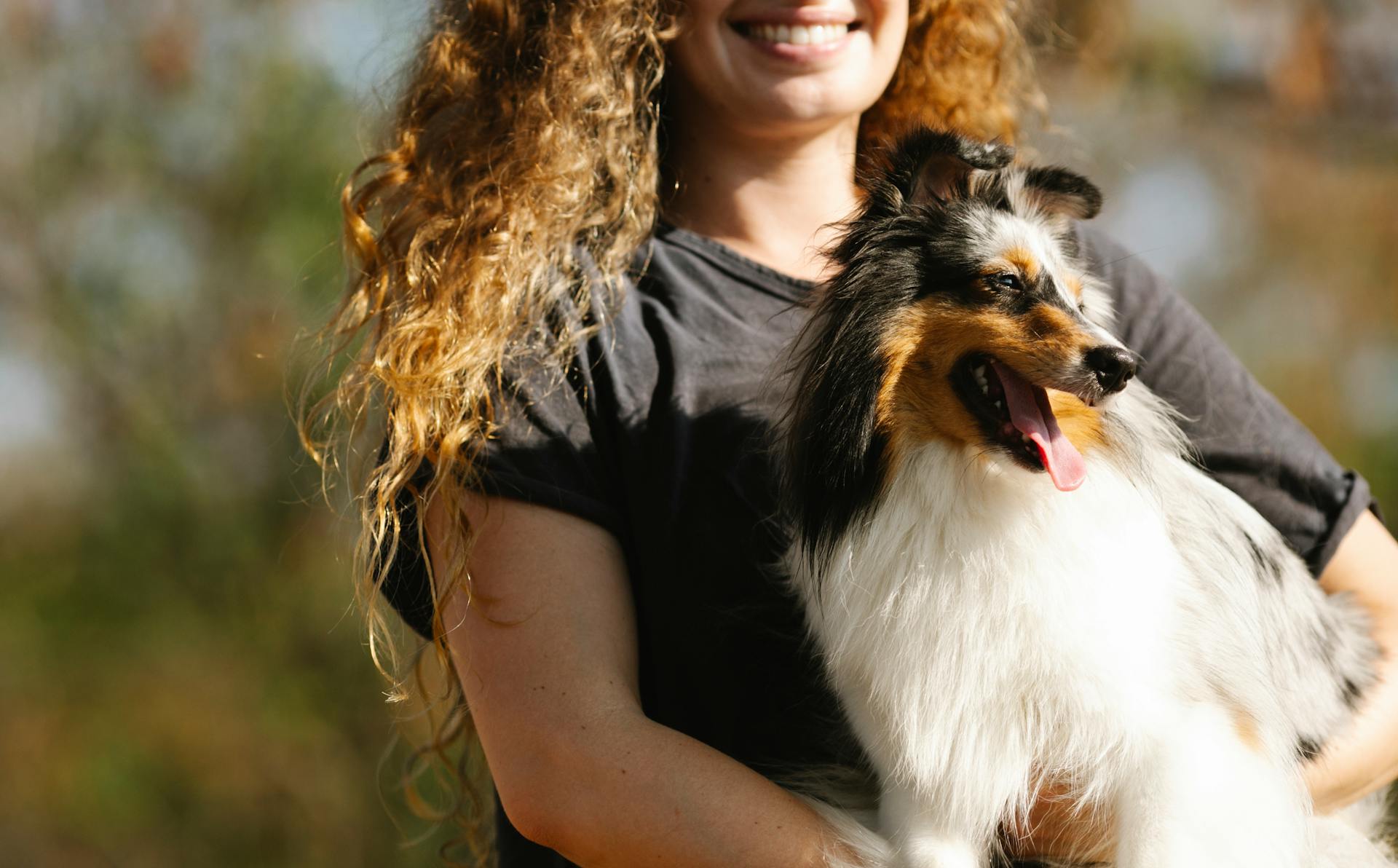
An average adult Sheltie, weighing around 15-25 pounds, may require about 1 to 1.5 cups of dry dog food per day. However, this is a general guideline, and it’s essential to monitor the dog’s weight and body condition, adjusting its food intake as necessary.
Treats should be given in moderation, and it’s best to remember that giving too many can contribute to obesity. Fresh water should always be available.
A different take: Best Food for Border Collies
Frequently Asked Questions
Do shetland sheepdogs bark a lot?
Yes, Shetland Sheepdogs are known to be vocal and bark frequently, making them good watchdogs. Their barking is often a warning to alert their family to potential strangers.
Are Shetland sheepdogs good house dogs?
Yes, Shetland Sheepdogs make excellent house dogs due to their intelligent and responsive nature. They thrive in homes with regular exercise, such as daily walks.
What are the cons of owning a Sheltie?
Shetland sheepdogs can be prone to health issues such as hip dysplasia and thyroid problems, and may also be quite vocal due to their alert nature
What is the difference between a Sheltie and a Shetland Sheepdog?
The terms "Sheltie" and "Shetland Sheepdog" refer to the same breed of dog. The breed is officially known as the Shetland Sheepdog, but "Sheltie" is a popular nickname used by many owners and enthusiasts.
Do Shetland sheepdogs like to cuddle?
Yes, Shetland sheepdogs are known to be affectionate and love to cuddle with their family members. They make great companions for those who enjoy physical affection and snuggles.
Featured Images: pexels.com

